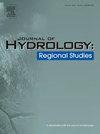Nitrate source and transformation processes in river water and groundwater in seasonal freezing and thawing region
IF 4.7
2区 地球科学
Q1 WATER RESOURCES
引用次数: 0
Abstract
Study region
The upper reaches of the Luan River Basin, located in the seasonal freezing and thawing regions, play a crucial role in the synergistic development of Beijing-Tianjin-Hebei.
Study focus
The intensification of human activities has led to the accumulation of nitrates in both river water and groundwater in the upper reaches of the Luan River. Clarifying the spatiotemporal characteristics and source of nitrate in river water and groundwater will be useful in developing seasonal nitrate protection strategies. Stable isotopes (δ15N-NO3- and δ18O-NO3-, δD-H2O and δ18O-H2O), water chemistry, and statistical analysis were employed to investigate nitrate sources and transformation processes in river water and groundwater.
New hydrological insights for the region
There were 3.44 % of river water samples and 26.44 % of groundwater samples exceeded the World Health Organization threshold for drinking water (50 mg/L). Nitrate pollution in river water was mainly concentrated during the freezing and thawing season, while in groundwater, it was predominantly concentrated during the rainy season and thawing period. The primary factors influencing nitrate levels in river water and groundwater were water chemistry and human activities, respectively. During the rainy season, nitrification was the predominant process contributing to nitrate levels in river water and groundwater, whereas denitrification processes were negligible. The mean contributions of manure and sewage (M&S) were highest in river water (51.9 %) and groundwater (71.6 %). Nitrate in precipitation (NP) and soil nitrogen (SN) constituted secondary sources for nitrate in river water and groundwater, with mean contributions of 22.5 % and 25.3 %, respectively. This study comprehensively investigates the impact mechanisms of freezing and thawing on the spatiotemporal patterns of nitrate in river water and groundwater. It refines the theoretical framework for nitrate migration and transformation in regional river and groundwater systems, thereby enhancing our understanding of the sources and processes of nitrate migration and transformation in areas with seasonal freezing and thawing.
求助全文
约1分钟内获得全文
求助全文
来源期刊

Journal of Hydrology-Regional Studies
Earth and Planetary Sciences-Earth and Planetary Sciences (miscellaneous)
CiteScore
6.70
自引率
8.50%
发文量
284
审稿时长
60 days
期刊介绍:
Journal of Hydrology: Regional Studies publishes original research papers enhancing the science of hydrology and aiming at region-specific problems, past and future conditions, analysis, review and solutions. The journal particularly welcomes research papers that deliver new insights into region-specific hydrological processes and responses to changing conditions, as well as contributions that incorporate interdisciplinarity and translational science.
 求助内容:
求助内容: 应助结果提醒方式:
应助结果提醒方式:


